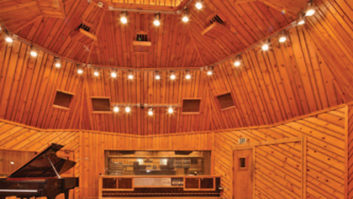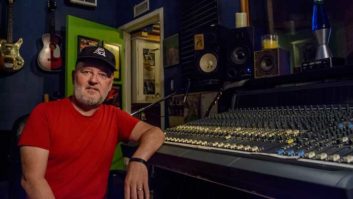While preferences in tools have always varied widely among audio content creators, recent years have prompted more producers to reconsider their choices to improve their work in a competitive marketplace. Here, we talk to five independent producers across the country about their evolving workflows, key gear choices and crucial upgrade decisions.
Songwriter, performer, sideman and engineer Jono Manson, owner of The Kitchen Sink studio in Santa Fe, NM, has spent four-plus decades in the music industry. Initially working in New York City with artists including Joan Osborne, Blues Traveler and Spin Doctors, Manson now hosts talents ranging from Amanda Palmer to T Bone Burnett at his New Mexico digs, making sure to include local artists in his audio adventures, too.
“While my production scheme, and philosophy, have remained pretty much constant—or at least evolved slowly—my workflow has, indeed, changed fairly drastically over the past several years,” explains Manson. “This is due largely to the fact that about a year and a half ago, I moved my studio into a much larger space.”
With more elbow room and a better sounding facilty, Manson is able to work more as he chooses, making records that involve a lot of live collaboration between musicians. Upgrading to a 32-channel Avid Pro ToolsHDX system, brand-new Audient ASP8024 analog console, and all new wiring throughout The Kitchen Sink have been wise choices, he finds, and going with a new console, rather than vintage, was primarily a logistic choice.
Nashville-based producer/drummer Ken Coomer (Uncle Tupelo, Wilco, Steve Earle, Emmylou Harris).

“The Audient is a great-sounding console and is extremely well-designed, very intuitive and flexible,” attests Manson. “We decided to go the route of installing a brand-new desk, partly because here in New Mexico, maintenance becomes an issue. There are very few people for hundreds of miles around who can fix anything! Unlike cities like New York or Los Angeles, Santa Fe is rather bereft of technical assistance for servicing vintage gear at short notice.” Manson also notes that he still relies upon outboard preamps and analog tape machines, too, when the mood is right.
Two years ago, Nashville-based producer/drummer Ken Coomer (Uncle Tupelo, Wilco, Steve Earle, Emmylou Harris) built his own studio, which he deems “fulfillment of a lifelong dream.” Balancing classic analog gear and the necessary digital tools, Coomer professes his passion for the former. “I love to track to tape,” he explains.
“I have an MCI 16-track two-inch machine that I absolutely love! Once we track drums and bass to tape, we dump over to Pro Tools 10 and start overdubbing as needed. There are so many great plug-ins out there. The SoundToys plug-ins are hard to beat.” “I have always been a huge fan of tape and analog recording,” Coomer continues. “When I first started playing on records in the late Eighties, tape was the way everyone recorded, but with the evolution of digital recording and Pro Tools—which I embraced early on—combining the two worlds of digital and analog made a lot of sense to me.”
Coomer’s studio features a custom API console, based around several 500 Series modules and the DSM 24 with three 8200 summing mixers. “There are certain pieces of gear that are usually in the vocal chain,” he explains. “I have an original Urei 1176 rev D that I can always count on for the vocals. Plus, being a drummer, I have to have the ‘drummer’s mic pres,’ a pair of Helios, Type 1R. I’m told these are the same that were used on Zeppelin records. Regardless they sound amazing!”
Producer/artist Daniel Levi Goans of Lowland Hum, a Charlottesville VA-based art folk band.

Over the past few years, producer/artist Daniel Levi Goans of Lowland Hum—a Charlottesville VA-based art folk band—has worked in such great-sounding, well-stocked studios as Mitch Easter’s Fidelitorium in Kernersville, NC; Chris Keup’s White Star Sound in Louisa, VA; and Jeff Crawford’s Arbor Ridge Studios in Chapel Hill, NC. These experiences have guided Goans to more carefully invest in his own studio, which he admits began as “kind of amateur home recording kit with a few surprises thrown in” such as a MacBook Pro running Logic Pro, an Apogee Duet 2, Empirical Labs Distressor, five ADK Microphones condenser microphones, an ADK AP-1 pre-amp and two Shure SM57s.
“I also consulted with a producer friend in Nashville who recommended I purchase two pieces of software—Voxengo Voxformer and Art Vista Virtual Grand Piano 2,” tells Goans. “With these basic tools, I got my start and began to experiment with unorthodox arrangements. My producing flowed directly out of my love for songwriting and my love of recorded music, not necessarily out of any interest in gear.”
Though not necessarily a gearhead, Goans took some early guidance from ADK’s Larry Villella at ADK Microphones, among others: “They are friends who’ve invested much of their lives in achieving excellence in the studio setting.”
Los Angeles-based engineer/musician/inventor Scott Eric Olivier.

“Between then and now, I’ve added a few game-changing pieces that have expanded the horizon a great deal when I am working at my own studio,” Goans continues. “Before starting the tracking on the third full-length Lowland Hum album, I purchased an Apogee Quartet, a Universal Audio 1176LN Limiting Amplifier, an API-3124+ preamp, a Nord Piano 2, a Silvertone 1481, an sE Electronics Reflexion Filter and a Blue Kiwi. The versatility of the Blue Kiwi with its varied patterns, the clarity of the API and the desert-island ubiquity of the 1176 have opened the way for a wider range of sonic innovation.”
Meanwhile, audio engineer/inventor Scott Eric Olivier of Los Angeles prefers to ride the bleeding edge of technology, creating new workflows as he works both live and in the studio. Along with developing his own PEDALpUNK! audio interface and META sample collection, he is a rather early adopter of AoIP routing in the studio as well as a multi-DAW recording process he calls enviralNET. “It is a blend of ProTools, Ableton Live and Logic Pro, all synchronized via SMPTE converted to MTC,” explains Olivier. “By using these DAWs in combination with PEDALpUNK! and Audinate’s Dante’ protocol, I’m able to create a robust network that can interface with any balanced or unbalanced gear in a live concert setting and deliver 24-bit, 96 kHz audio to monitor and FOH engineers. This schema has been proven in concert with Gwen Stefani, No Doubt, and Goo Goo Dolls.”
Looking at studio and live production environments simultaneously, Olivier has fully committed to Focusrite RedNet and Dante. “I went from a serial network to a server/client hub nearly overnight,” he explains. “The resolution has more than doubled—from 44.1 kHz to 96 kHz—and I can control a whole studio or stage, including iOS and Android devices, from one master computer in the network. This process has also proven road-worthy, as I’ve used it in 250-plus concerts since 2012.”
Producer/mix engineer/session guitarist Michael James (Hole, Robbin Ford, Kalimba, Chicago, Jane’s Addiction).

Also based in Southern California, producer/mix engineer/session guitarist Michael James (Hole, Robbin Ford, Kalimba, Chicago, Jane’s Addiction) chose to avoid investing in the “big console” and instead, zero in on outboard investments. “I was planning to purchase an SSL 9000 J/K when I first moved from LA’s rat race to Simi Valley’s open spaces,” recalls James. “The fresh air helped me come to my senses and spec my private mix room with a wide variety of my outboard gear from Dangerous Music, Manley Labs, Chandler Limited, Tonelux, Avalon Designs, Empirical Labs and other boutique pro audio designers. I realized that I could make my own custom analog console by filling all 72 RU of a Sterling Modular Plan B mastering console with the “sweet spot” pieces—like EQs and buss processors—and adding moving faders. The rest of the “non sweet spot” control room outboard gear resides in 80 spaces of the producer racks that used to travel with me. Those racks contain mostly compressors and limiters that I use on inserts, not busses. You can get away with bigger manipulation of individual tracks than you can with program material, like a mix or sub-mix, where a little bit goes a long way. Plus or minus 6 dB of EQ or gain reduction may be appropriate to add excitement to a vocal, bass or drum, but it would mangle a mix. All the stuff that needs to be adjusted with surgical precision is in the sweet spot on my console.”
Like Olivier, James admittedly works “hybridly” when it comes to software. “Avid Pro Tools HDX is the recorder/workstation where I write copious automation and strategically deploy a small suite of highly effective plug-ins,” he offers, “like the Sound-Toys bundle for effects; MDW EQ for filtering and cuts; UA’s UAD2 Octo PCI and Eventide Tverb for reverb emulations; Empirical Labs Arouser for extra Distressor-inspired spank; and old-school Sound Replacer or modern Slate Trigger for the rare occasions when I need to add a drum sample. I use Native Instruments Komplete 11 Ultimate and Toon-Track Superior Drummer for all my digital composition and arrangement needs. Dangerous Music Convert-8s handle up to 64 channels of D-A output conversion to the Dangerous summing mixers and Lynx Aurora 16 units supply up to 128 channels of AD/DA I/O for my hardware inserts in Pro Tools.”
Despite the long list of drool-inducing outboard, James admits that his favorite investments as of late have been purely practical, yet unique. “Believe it or not, the two most important additions to my room have been Nicecast [broadcast audio software] and a Rivera Silent Sister isolation cabinet for guitar speakers,” he explains. “They have both given me a better quality of life, quite literally. Nicecast saves me hours of back-and-forth with artists as we approach the finish line—no uploading of mp3s, no waiting for comments, and more time to spend with my loved ones away from the studio. The Silent Sister is great for me because it unassumingly occupies a small corner of the room, prewired with a Royer R121 ribbon and a Sennheiser MD421 dynamic mic, phase aligned and ready for me to bust out a face-melting jam with zero setup time and zero ear fatigue, right in the middle of the mix when the artist or I have a ‘lightbulb’ flash of inspiration that leads to a guitar overdub.”



